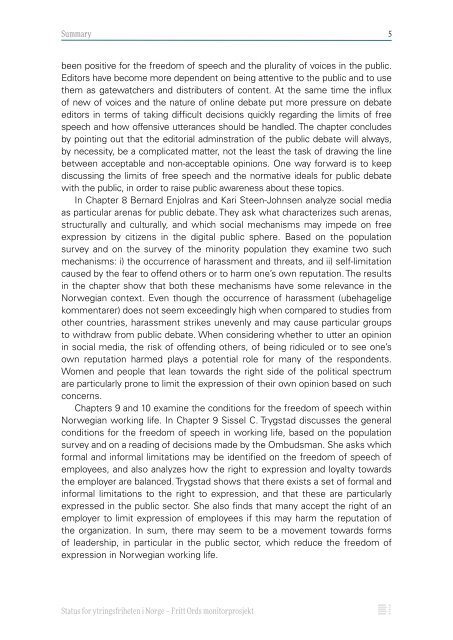Ytringsfrihet Hovedrapport DIG (3)
Ytringsfrihet Hovedrapport DIG (3)
Ytringsfrihet Hovedrapport DIG (3)
Create successful ePaper yourself
Turn your PDF publications into a flip-book with our unique Google optimized e-Paper software.
Summary5been positive for the freedom of speech and the plurality of voices in the public.Editors have become more dependent on being attentive to the public and to usethem as gatewatchers and distributers of content. At the same time the influxof new of voices and the nature of online debate put more pressure on debateeditors in terms of taking difficult decisions quickly regarding the limits of freespeech and how offensive utterances should be handled. The chapter concludesby pointing out that the editorial adminstration of the public debate will always,by necessity, be a complicated matter, not the least the task of drawing the linebetween acceptable and non-acceptable opinions. One way forward is to keepdiscussing the limits of free speech and the normative ideals for public debatewith the public, in order to raise public awareness about these topics.In Chapter 8 Bernard Enjolras and Kari Steen-Johnsen analyze social mediaas particular arenas for public debate. They ask what characterizes such arenas,structurally and culturally, and which social mechanisms may impede on freeexpression by citizens in the digital public sphere. Based on the populationsurvey and on the survey of the minority population they examine two suchmechanisms: i) the occurrence of harassment and threats, and ii) self-limitationcaused by the fear to offend others or to harm one’s own reputation. The resultsin the chapter show that both these mechanisms have some relevance in theNorwegian context. Even though the occurrence of harassment (ubehageligekommentarer) does not seem exceedingly high when compared to studies fromother countries, harassment strikes unevenly and may cause particular groupsto withdraw from public debate. When considering whether to utter an opinionin social media, the risk of offending others, of being ridiculed or to see one’sown reputation harmed plays a potential role for many of the respondents.Women and people that lean towards the right side of the political spectrumare particularly prone to limit the expression of their own opinion based on suchconcerns.Chapters 9 and 10 examine the conditions for the freedom of speech withinNorwegian working life. In Chapter 9 Sissel C. Trygstad discusses the generalconditions for the freedom of speech in working life, based on the populationsurvey and on a reading of decisions made by the Ombudsman. She asks whichformal and informal limitations may be identified on the freedom of speech ofemployees, and also analyzes how the right to expression and loyalty towardsthe employer are balanced. Trygstad shows that there exists a set of formal andinformal limitations to the right to expression, and that these are particularlyexpressed in the public sector. She also finds that many accept the right of anemployer to limit expression of employees if this may harm the reputation ofthe organization. In sum, there may seem to be a movement towards formsof leadership, in particular in the public sector, which reduce the freedom ofexpression in Norwegian working life.Status for ytringsfriheten i Norge – Fritt Ords monitorprosjekt


